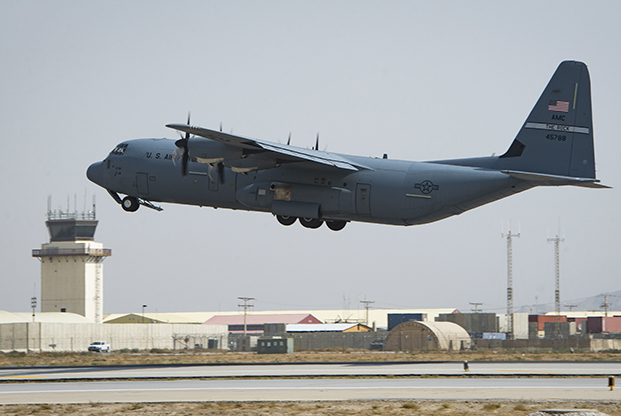
A C-130J takes off from Bagram Airfield, Afghanistan. USAF saw a huge increase in airdrops over Afghanistan in 2018—most flown by Super Hercules crews and airmen from Little Rock AFB, Ark. Photo: SSgt. Benjamin Gonsier
NEED FOR AIRDROPS SKYROCKETS IN AFGHANISTAN
By Brian W. Everstine
The number of airdrops conducted in Afghanistan last year increased nearly 1,900 percent from 2017, and the airmen tasked with providing this capability to US and allied forces on the ground did so at a perfect rate.
In 2018, US aircraft air-dropped a total of 667,880 pounds of supplies across Afghanistan, up from just 33,423 in 2017, zero in both 2016 and 2015, and just 28,000 in 2014. In 2013, the last time US aircraft flew a higher rate of airdrops, the US military had more than 65,000 troops in the country, compared to about 16,000 in mid-2018.
The increase was coupled with a dramatic spike in air strikes—2018’s total of 7,362 was more than the previous three years combined, and the highest total since at least 2009, according to data provided by Air Forces Central Command.
These numbers show the fight in Afghanistan is far from over. Even as US negotiators work toward a framework for peace with the Taliban, ISIS-Khorasan remains a threat. AFCENT, in a statement to Air Force Magazine, would not specifically provide details on how its operations changed, saying only that weather changes, the movement of forces, and resupply needs can shape how mobility missions occur.
“We operate in a dynamic, ever-changing AOR [area of responsibility], and therefore the movement of assets and resupply missions vary,” AFCENT spokeswoman Capt. Holly Brauer said in a statement.
The huge increase in airdrops, which were largely flown by C-130Js and airmen primarily from Little Rock AFB, Ark., can be attributed to the evolving fight.
“The difference I noticed wasn’t a change in the pace of operations or a build up and draw down. It was more where we were … flying into. It was where the fight was being fought,” said Capt. Michael Morrison, a C-130J pilot with the 41st Airlift Squadron. Morrison couldn’t say exactly where the fighting was taking place, but he said the more remote, mountainous areas did not have “a suitable airfield, so we have to do the airdrop instead.”
In January 2018, when the airmen and aircraft from Little Rock deployed to Bagram Airfield, Afghanistan, the pace of airlift operations was “business as usual.” Aircrews flew approximately every other day, about four lines per day, doing “air-land” cargo deliveries—meaning they would land on a remote airstrip at an established forward operating base.
However, as the deployment progressed, operations in Afghanistan shifted. US, coalition, and Afghan forces fought more in eastern Afghanistan, in places like the remote and mountainous Nangarhar province, against ISIS-Khorasan fighters who had holed up in these harsh areas. Also in early 2018, the Army deployed its first Security Forces Assistance Brigade to rural outposts to train small units of Afghan forces in areas closer to Taliban strongholds and to assist soldiers who needed regular resupply. These SFAB teams augmented existing US and allied Expeditionary Advisory Packages deployed with Afghan forces throughout the country.
Aircraft were needed to supply forces in rough areas and operate at a pace that was “minimizing our level of exposure,” said Capt. Jonathan Cordell, a C-130J pilot with the squadron, who was the tactics officer while deployed.
This meant more remote forward operating locations, without airstrips, and in contested areas. Resupplies had to be rethought, and the Combined Air Operations Center at Al Udeid AB, Qatar, soon called on the C-130Js to air-drop supplies.
From the beginning of the deployment until the end of March, there was not a single pound air-dropped in Afghanistan. By the end of April, aircraft had dropped 135,840 pounds, with 191,400 more in May, and 126,000 pounds air-dropped in June. The rate dropped through the end of summer before picking back up at the end of the year, according to AFCENT data. The increase in airdrops “is something—to be honest—no one really had expected to do once we got out to Afghanistan,” Morrison said. “We knew it was definitely a possibility, and we could carry out that kind of stuff.”
At first, the C-130Js solely landed and rolled off cargo, but by late spring, they were flying airdrop missions roughly once per week.
“It’s a tribute to the C-130’s flexibility, and our ability to go anywhere, anytime. We‘ll carry out the mission and get it done,” Morrison said. “We do that better than any airplane.”
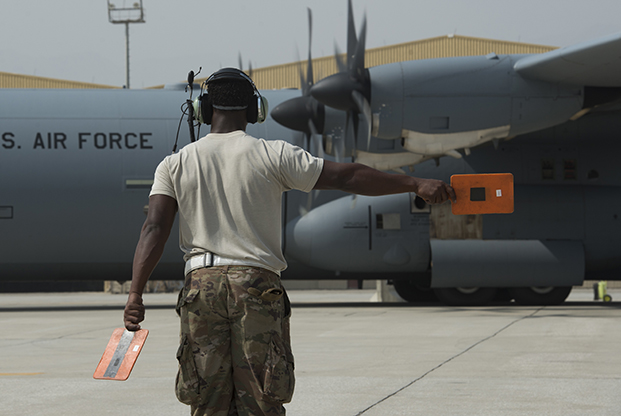
A1C Dominick Partlow marshals a C-130J at Bagram Airfield, Afghanistan. Photo: SSgt. Benjamin Gonsier
In May 2018, C-17s got back in the fight, when an Al Udeid-based Globemaster dropped more than a dozen pallets in southern Afghanistan—the aircraft type’s first airdrop within the US Central Command AOR in 18 months. The Afghan Air Force also increased its capability, with its first emergency airdrop from a C-208 in June of that year.
The Little Rock crews tallied a 100 percent recovery rate throughout their deployment, which ended in June—their pallets landed on-target, and friendly crews were able to pick them up immediately. After the drops, aircrews would make sure to connect with the ground forces to ensure everything was picked up, and plan ways to improve the process for future drops, Cordell said.
Sometimes the soldiers would make personal requests, but, unfortunately, the aircrews were “not a part of that decision-making process,” he said.
The missions were planned days or weeks in advance, with soldiers working with loadmasters to prepare the bundles for airdrops after tasks came in from the CAOC. Airdrop missions took more time to prepare because the bundles had to be outfitted with parachutes and readied to be tossed out the back of an aircraft. But it also allowed for a faster turnaround on missions. At times, an aircraft could air-drop a load of supplies, then land to roll on more pallets for a traditional air-land mission right away, said A1C Matt Madson, a C-130J loadmaster with the squadron.
At one point in early May, a Resolute Support Expeditionary Advisory Package in a remote mountainous area needed a large resupply, one that couldn’t be carried by one C-130J. Instead of using a different aircraft, such as a C-17, or doing multiple passes into a hostile area, the CAOC brought in another C-130J and airmen from the 746th Expeditionary Airlift Squadron at Al Udeid Air Base comprised of Reserve airmen deployed from the 403rd Wing at Keesler AFB, Miss. The two C-130Js flew in tight formation through the night to drop the supplies nearly simultaneously to the friendly forces. This type of mission was “more tactically sound, with less exposure time,” pilot Capt. Christian Fontaine said.
It was the first time C-130Js from separate bases, in different countries, flew a dual-formation airdrop in the 18-year-long war. The two squadrons practiced the exact mission set before deployment, during spin-up training at the Green Flag-Little Rock training exercise in Arkansas. These types of missions are conditioned regularly back home, but had not been flown in Afghanistan under the same circumstances.
The mission provided lots of equipment to soldiers on the ground safely and was a “timely, awesome proof of concept,” said Capt. Mark Hunkins, a C-130J pilot with the squadron.
As the deployment progressed, the airmen and mission planners were able to refine their tactics and capability. Maintainers kept the aircraft at a high mission capable rate, because “canceling a line, that means people and cargo aren’t getting to where they need to,” Morrison said.
“We pride ourselves in being professional aviators,” said Morrison. “We want to be the guys in the squadron that the Army calls when they need something done. We want them to call us first. We don’t want them to call C-17s. … We want them to call us. We can take care of them, they know what they’re going to get, and they’re going to get it on time.”
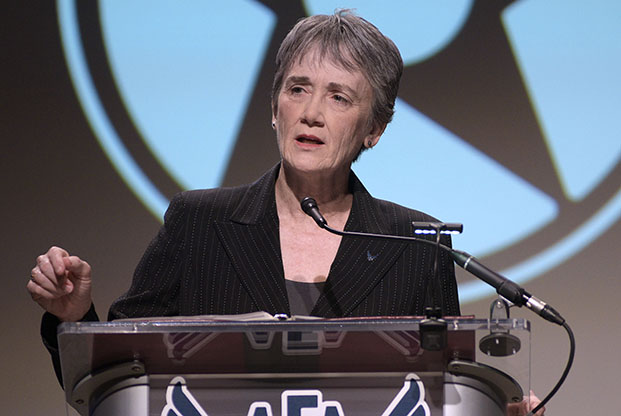
Secretary of the Air Force Heather Wilson will depart the Air Force May 31. Photo: Mike Tsukamoto/staff
SECRETARY WILSON WILL RESIGN, LEAD UNIVERSITY OF TEXAS AT EL PASO
Air Force Secretary Heather Wilson resigned effective May 31 to become president of the University of Texas at El Paso after two years as the service’s civilian leader.
“I am proud of the progress that we have made restoring our nation’s defense,” Wilson said in a statement. “We have improved the readiness of the force; we have cut years out of acquisition schedules and gotten better prices through competition; we have repealed hundreds of superfluous regulations; and we have strengthened our ability to deter and dominate in space.”
If a new nominee is not confirmed by her departure date, undersecretary Matt Donovan will fill the top job until a new Secretary is confirmed.
In her March 8 resignation letter, Wilson said she expects to start her new job Sept. 1.
“This should allow sufficient time for a smooth transition and ensure effective advocacy during upcoming congressional hearings,” she wrote.
Wilson has held prior leadership roles in academia and the University of Texas El Paso is close to her family’s home in New Mexico.
A strong proponent of broadening the military’s outreach to research universities, Wilson would return to a familiar career in academia. She left the South Dakota School of Mines and Technology after four years as its president to become Air Force Secretary and has since pushed to modernize the service’s acquisition and science and technology enterprises.
A former member of Congress who is widely respected on Capitol Hill, Wilson had been seen as a possible successor to James Mattis as the next Defense Secretary and the first woman to fill that post.
“The importance of her incredible work in the Air Force cannot be overstated,” Rep. Mike Turner (R-Ohio), the ranking member on the House Armed Services strategic forces subcommittee, said. “It is not surprising to me that Heather would be sought out by other organizations looking for her strong leadership. … Hopefully, someday we can see Heather Wilson as the first female Secretary of Defense.” —Rachel S. Cohen
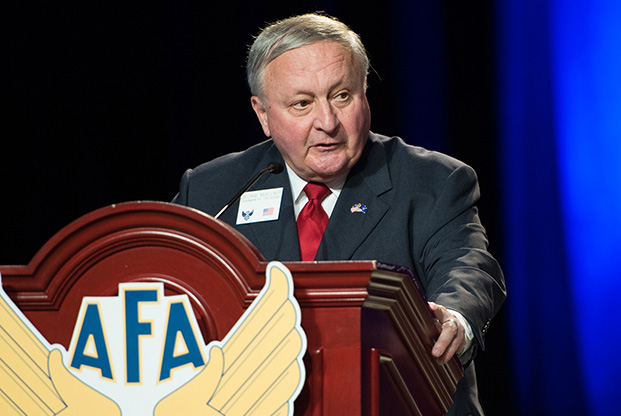
George Muellner, then-AFA Chairman of the Board, speaks at an AFA event. Mike Tsukamoto/staff
TRIBUTE
GEORGE K. MUELLNER: 1943-2019
By John A. Tirpak
George Muellner, retired Air Force lieutenant general, fighter pilot, test pilot, a classified programs specialist, a top technologist for Boeing, a senior leader of the aerospace industry, leader of a number of aerospace societies and associations, and former Air Force Association Chairman of the Board, died Feb. 11 in Newport Beach, Calif. He was 75.
Muellner earned his commission through the ROTC program at the University of Illinois, after earning his bachelor’s in aeronautical and astronautical engineering. He later earned three master’s degrees: in aeronautical systems management, electrical engineering, and business administration. During his career he also completed the Naval War College and Air War College.
Joining the Air Force in 1968, Muellner learned to fly the F-4 Phantom, and in the course of two tours in Southeast Asia, amassed 690 combat missions during the Vietnam War, receiving three awards of the Distinguished Flying Cross and 27 awards of the Air Medal, among other decorations. On one mission, he was shot down and made a narrow escape from enemy forces by clinging to the skids of a helicopter.
In 1973, he became a test pilot, and over the next nine years flew a wide array of aircraft, amassing a lifetime total of 121 different types. He flew operational tests on the then-new F-15 and was a member of the F-16 Combined Test Force.
Muellner then joined, and later commanded, the 6513th Test Squadron, known as the “Red Hats,” where he was involved in obtaining and testing Soviet-design combat airplanes used for technical evaluation and to provide high-fidelity air combat training of US fighter pilots.
After Air War College, he served in a variety of assignments in Europe from 1983-1987, flying the F-15 and F-16, concluding with a tour as director of operations for the 36th Tactical Fighter Wing at Bitburg AB, Germany; the “tip of the spear” for the US during the Cold War.
Back from Europe, Muellner worked in the requirements shop at Tactical Air Command at Langley AFB, Va. He then went into program management.
While he was directing the Joint Surveillance Target Attack Radar System program, the first Gulf War erupted. Muellner formed and commanded the 4411th JSTARS Squadron and took two experimental E-8 JSTARS aircraft to the war, years before the system would go through initial operational test and evaluation. The JSTARS were pivotal in detecting the Iraqi move against Khafji and directing attacks on those and follow-on forces to the north of the Kuwaiti border. The deployment signaled an end to US adversaries being able to move ground forces under cover of darkness.
Muellner then went back to be the deputy chief of requirements at TAC, and at its successor, Air Combat Command. A Pentagon job followed, as director of command and control and weapon programs under the assistant secretary of the Air Force for acquisition.
In 1993, Muellner was appointed to head the Joint Advanced Strike Technology (JAST) program. Its mission was to harmonize the requirements of the Air Force, Navy, and Marine Corps for a new combat aircraft that would be used by all three services. Muellner’s task was to establish the parameters of the new fighter—meeting unique service requirements for speed, range, carrier operations, vertical landing, etc.—in a largely common airframe that could save money by achieving production scale on spare parts, training systems, software, etc. The result was the Joint Strike Fighter program, and a flyoff between the Boeing X-32 and Lockheed Martin X-35. The latter was selected, and became the F-35, which is planned to be the “backbone” of USAF’s fighter force.
Muellner’s last USAF assignment came in 1995, when he served as the top uniformed deputy to the assistant secretary for acquisition. In that position he oversaw production of the F-22 fighter and B-2 bomber, C-17 airlifter, and a variety of classified and unclassified projects, such as the Joint Air-to-Surface Standoff Missile, or JASSM. He retired from the Air Force in 1998, after 31 years of service.
He joined Boeing that same year, serving at first as vice president and general manager of Boeing’s Phantom Works advanced research and development unit, later becoming president in 2001. The following year, he became vice president and general manager of Air Force systems. He then became president of advanced systems, integrated defense systems.
Among the classified products produced under his Boeing tenure were the stealth helicopters involved in the raid that killed Osama bin Laden, which were based on technology developed for the Boeing-Sikorsky RAH-66 Comanche helicopter the Army had canceled.
He retired from Boeing in 2008, continuing as a consultant to the company.
He also served on a number of corporate boards.
Muellner continued to provide leadership, mentorship, and advice through the years that followed. He served as president of the American Institute of Aeronautics and Astronautics, as a member of the Air Force Scientific Advisory Board, Defense Science Board Intelligence Task Force, and vice chairman of the Board of the Aerospace Corporation.
Muellner was virtually a lifelong member of the Air Force Association, holding many positions over the years with the Aerospace Education Council and at all levels of the organization. He was Chairman of the Board from October 2012 through September 2014, and during his tenure he nurtured and expanded AFA’s CyberPatriot program, which involves middle and high school students in a cyber defense competition. He oversaw an agreement for AFA to take over the Wounded Airmen Program from the Air Force, which provides assistance to wounded Air Force personnel as they return from war. Muellner also represented AFA on Capitol Hill, articulating the importance of air, space, and cyber power.
He established the George and Vicki Muellner Foundation Scholarship, which provides annual scholarships for deserving students in the Arnold Air Society and Silver Wings—AFA sister organizations for college students.
Among his many honors, Muellner received the Defense and Air Force Distinguished Service Medals and the Legion of Merit; he was elected to the National Academy of Engineering; a Fellow of the Society of Experimental Test Pilots; a Fellow of the Royal Aeronautical Society, AFA’s Theodore von Karman Award; the National Defense Industrial Association’s Bob Hope Distinguished Citizen Award; the Aerospace Test Pilot Walk of Honor; and Aviation Week’s Curtis Sword Award.
“We are saddened by the loss of a model airman, model leader, and model friend,” said retired Gen. Larry Spencer, former president of AFA. “George Muellner was a force for the Air Force, AFA, and our country. He will be missed.”
CYBERCOM CHIEF: 133 CYBER TEAMS WILL BE INSUFFICIENT AS ADVERSARIES IMPROVE
US Cyber Command views its existing cadre of cyber warriors as a starting point for growth as the Pentagon pivots to compete with more tech-savvy adversaries, the command’s top general told lawmakers in February.
Army Gen. Paul Nakasone, who also directs the National Security Agency, said at a Senate Armed Services Committee hearing he expects to need more people to conduct operations as adversaries improve. The US is chiefly concerned about mounting threats from Russia, China, North Korea, Iran, and some non-state actors.
“As we measure our readiness against what we consider a number of different adversaries, primarily both near-peer and rogue states, we believe that the teams that we’ve created right now is the building block for that,” Nakasone said. “We are also … building a series of defensive teams in the Army Reserve and the National Guard that are going to be a strategic depth for us.”
After some delays, the Pentagon finished creating 133 Cyber Mission Force teams with members from all three services last year. While the Defense Department has other groups that also wage offensive and defensive cyber operations, the new teams report directly to CYBERCOM and reflect the government’s recent embrace of network combat.
More than 6,200 soldiers, sailors, airmen, Marines, and civilians tackle four missions as part of the Cyber Mission Force, according to the Pentagon. Cyber national mission teams find enemy activity, block their attacks, and defeat them. Cyber combat mission teams supply cyber operations for combatant commanders around the world. Cyber protection teams defend DOD networks, are assigned to “priority” missions, and prepare offensive cyber forces for combat. Cyber support teams provide analysis and planning support to national and combat mission teams.
The challenge, Nakasone said, is to retain the best of the best — those he calls “10 or 20 x type of people” because they are 10 and 20 times better than their cohorts at developing software, analyzing malware and coding. —Rachel S. Cohen
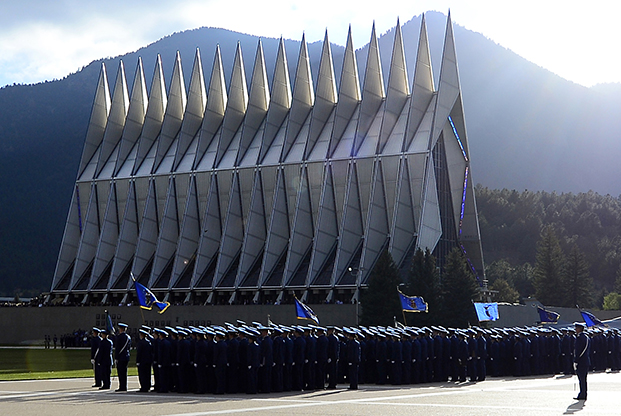
Air Force cadets in formation near the chapel on the grounds of the Air Force Academy in Colorado Springs, Colo. Photo: Darcie Ibidapo/USAF
REPORT: AIR FORCE ACADEMY HAS A SEXUAL ASSAULT, UNWANTED SEXUAL CONTACT PROBLEM
Nearly half of female Air Force Academy cadets said they were sexually harassed during the 2017-2018 academic year—but only one formal report was filed, according to a new Defense Department report on sexual harassment and violence at the nation’s three military academies.
In all, 46 percent of Air Force Academy cadets reported being harassed, compared with 48 percent of female cadets at the Military Academy at West Point and 56 percent of female midshipmen at the Naval Academy.
A DOD survey of students from all three schools also found that the number of female Air Force cadets experiencing unwanted sexual contact—defined as anything from being sexually touched without consent up to and including rape—rose from 11.2 percent in 2016 to 15.1 percent in 2018. However, only 13 percent of all female academy cadets said they reported these attacks.
West Point also saw an increased rate of unwanted sexual contact since 2016.
The report cited several “concerning climate-related trends,” including:
- Decreased willingness from cadets of both sexes to call out fellow cadets when gender-related rhetoric “crossed a line.” as compared with the previous period.
- Decreased willingness from cadets of both sexes to seek institutional help to stop sexual harassment among classmates.
- Decreased number of female cadets who believed academy officers’ actions and speech “set good examples.”
Fewer female cadets did express faith, however, that senior Academy leaders “made honest and reasonable efforts to stop sexual assault and harassment.”
Air Force Secretary Heather Wilson, herself an academy graduate, said the report predated a number of changes made at the Academy in 2018. She also expressed concern that cadets lacked faith in their peer leaders at the school.
“These are going to be lieutenants dealing with operational units, some of them within months or a few years,” Wilson said. “They, as young leaders, need to look carefully at the culture within their unit, as the cadet wing, and tell us what they think they can do to impact that culture.”
Air Force Academy Superintendent Jay Silveria said the academy “will aggressively” advance a nationwide conversation about stopping sexual assault and harassment on college campuses.
Wilson also said the nation’s service secretaries agree that the academies “need to lead on this issue.” The military schools have better, deeper, and more current data than most civilian schools and a track record of implementing successful programs to combat negative behavioral trends. “The Naval Academy will host the first national summit on sexual assault prevention and response” this spring, with support from all of the military services.—Jennifer-Leigh Oprihory
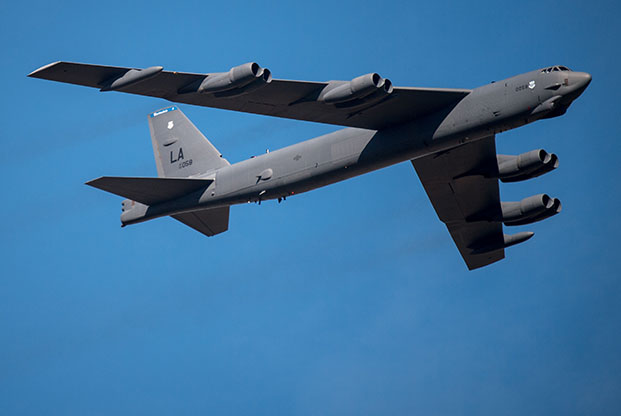
A B-52 during Global Thunder at Barksdale AFB, La., in November. Photo: SrA. Philip Bryant
BARKSDALE TESTS UPGRADED B-52 WEAPONS SYSTEM
Airmen at Barksdale AFB, La., are testing an upgrade to the B-52’s weapons systems that can nearly double the amount of smart weapons carried by the bomber. The 49th Test and Evaluation Squadron, in concert with other Barksdale units, recently installed an upgraded Conventional Rotary Launcher to a bomber at the base, which increases the launcher’s payload from four smart weapons each to eight. The test included eight AGM-158 Joint Air-to-Surface Standoff Missiles. With the new system, a B-52 can carry 20 smart weapons on the launcher and pylons under the wing, as opposed to the current total of 16, according to a Barksdale release. “Now, a B-52 going into a war zone has the ability to put 20 munitions on a target area very quickly,” SMSgt. Michael Pierce, the 307th Maintenance Squadron aircraft armament superintendent, said in the release. “Before, they would have to drop some of their munitions, power up the CRL again, and then make another pass.”
US CONDUCTS OPEN SKIES FLIGHT OVER RUSSIA
An Air Force OC-135B began conducting Open Skies Treaty observation flights over Russia in February, the first time the specially equipped aircraft has flown in that country in almost a year-and-a-half because of an “impasse” regarding treaty member nations.
The OC-135B, assigned to the 55th Operations Group at Offutt AFB, Neb., began observation flights Feb. 21, flew through Feb. 22, and departed Russia on Feb. 23, Pentagon spokesman Lt. Col. Jamie Davis said in a statement.
Russia was made aware of the flight on Feb. 12, and six Russian observers were on board the flight, per treaty procedures.
The US and Russia have regularly conducted these flights since the treaty went into effect in 2002; however, this was the first flight since November 2017 because of an “impasse that prevented standard Treaty flights for all states parties throughout 2018,” Davis said. The impasse preventing these flights was related to disagreements between Russia and Georgia, according to the Pentagon.
In addition, the US had declined to certify the Russian version of the treaty aircraft, a Tu-214, until it was inspected by US and allied partners last fall, according to the State Department. —Brian Everstine
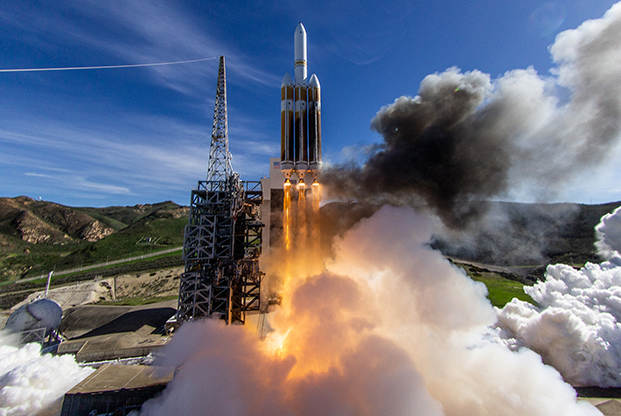
A United Launch Alliance Delta IV Heavy rocket carrying an NRO payload lifts off on Jan. 19. Photo: ULA
ULA, SPACEX SPLIT LATEST LAUNCH SERVICES CONTRACT AWARDS
The Air Force has tapped United Launch Services and SpaceX to provide launch services for six national security space missions, together worth nearly $740 million, under the Evolved Expendable Launch Vehicle program.ULS, the Colorado-based subsidiary of United Launch Alliance, won a larger share of funding at $441.8 million for up to three missions: the secretive “Silent Barker” space situational awareness program, Lockheed Martin’s fifth Space-Based Infrared Surveillance Geosynchronous Earth Orbit satellite, as well as an option to launch SBIRS GEO-6.
California-based SpaceX received $297 million to launch two classified National Reconnaissance Office payloads known as NROL-85 and NROL-87, as well as AFSPC-44, an Air Force Space Command satellite.EELV, which starting in March will be known as the National Security Space Launch program thanks to a recent legislative tweak, aims to increase competition among US launch providers to drive down the cost of putting defense and intelligence systems on orbit. The Air Force’s Space and Missile Systems Center received two offers for each set of contracts it awarded.
The missions are expected to launch from Cape Canaveral AFS, Fla., and Vandenberg AFB, Calif., between February 2021 and March 2022.
AFSPC-44 should be ready to launch by February 2021, while NROL-85 and -87 are expected to enter space by December 2021. Silent Barker is slated for launch by March 2022. SBIRS GEO-5 launch is planned for March 2021, ULA said, and SMC noted SBIRS GEO-6 may launch in Fiscal 2022.
This is the sixth competition held under Phase 1A of the EELV program.—Rachel S. Cohen
THE WAR ON TERRORISM
Casualties:
As of March 11, a total of 64 Americans had died in Operation Freedom’s Sentinel in Afghanistan, and 75 Americans had died in Operation Inherent Resolve in Iraq, Syria, and other locations..
The total includes 134 troops and five Department of Defense civilians. Of these deaths, 64 were killed in action with the enemy while 75 died in noncombat incidents.
There have been 374 troops wounded in action during OFS and 77 troops in OIR.
